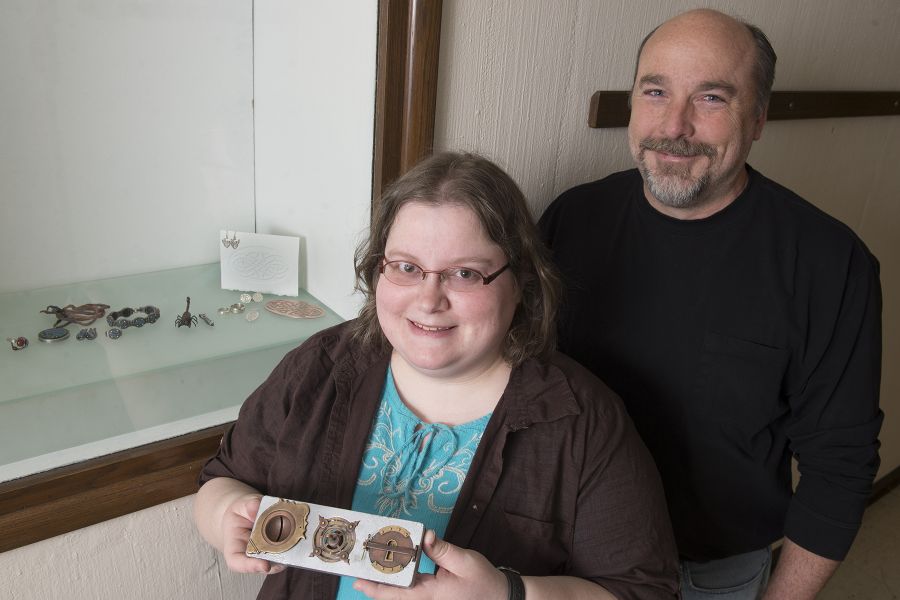Assistant Professor Randy Reid, M.F.A. ’96, is showing students how to turn semiprecious metals and gemstones into works of art in his Metalwork and Jewelry Design course. Throughout the semester students learn to solder, buff, file, and polish, and use those skills to develop their own creations.
There are no expectations of previous experience for students in the first level of the course. Reid shows them how to work with copper, nickel, brass, and eventually silver. Three projects are completed by the end of the semester—a pair of earrings, a pendant based on animal imagery, and a sterling silver ring with a gem bezel.
“The main thing I want to push into them is a sense of design and finding their own style to bring their ideas to life in a jewelry piece,” Reid said. “Good design is just as important as learning skills. It’s 50-50.”
Reid, who studied under Professor Dennis French at Illinois State, works to instill a sense of craftsmanship and understanding of art history relating to the craft of metalsmithing. Having worked on the commercial side of jewelry making, Reid presses his students to refine and perfect their skills and ideas.

Jennifer Wehage’s began working with leather and beads before coming to Illinois State. She is now working wonders with precious metals and gems.
“Especially in a jewelry setting, craftsmanship is paramount because of the scale you’re working at,” said Reid, from Illinois State’s School of Art. “People scrutinize it very closely when they pick it up.”
A strong sense of craftsmanship becomes even more important when students begin the ring project, which involves working with sterling silver and a gemstone of each student’s choosing. An activity fee covers the cost of the silver, as well as a kit that includes a set of files, solder, saw frame, and saw blades. Reid invites a gem dealer to the classroom with enough gems to cover three work benches. The gems, sold at wholesale, range from 50 cents to $500. Students can purchase whatever they want to work with, though Reid typically advises students to steer away from the extravagant end until they are at more advanced levels.
Reid’s four levels of Metal Work and Jewelry Design are rising in popularity. The two “level one” sections regularly fill to capacity, and the fall 2015 semester will see his Wood and Metal Design class full as well. Students who complete all levels go on to work as commercial jewelers, open their own studios, and run their own businesses.
“If you continue on (through all levels of the course), you learn enough skills here that you can get a job as a bench jeweler,” Reid said. “It’s an employable niche in the arts.”
Reid, who also teaches woodworking courses, will be offering a beginning wood and metalworking course this fall that will teach students to blend the materials.
“I push for a crossing over of the mediums,” Reid said. “More than one material can actually bring a piece to a higher place. It’s beautiful seeing two materials together.”
That philosophy has inspired Jennifer Wehage, a senior pursuing her BFA with a concentration in jewelry and metal work, to combine paper and metal work in her art. Wehage saw the potential for reusing discarded copper plates from her print making course and incorporated them into her jewelry work. The result is a unique fusion of paper and metal that will be unveiled in the BFA art show in June.
“You can make anything if you have the know-how,” Wehage said. “It’s fun playing and figuring out how components can be put together.”
Wehage will graduate in May 2016 and hopes to work for a jeweler as a wax carver before opening her own studio.
Some of Reid’s work for the University can be viewed throughout campus. He recreated a top ornament for the Fell Gates, has done bronze work on the Lincoln Gates, was the creator of The Replica of the Old Main Bell, and has created several battle birds, complete with wooden bases, for the University.
Steven Barcus can be reached at srbarcu@IllinoisState.edu.



2 thoughts on “Metalwork and Jewelry Design course is hidden gem in CFA”